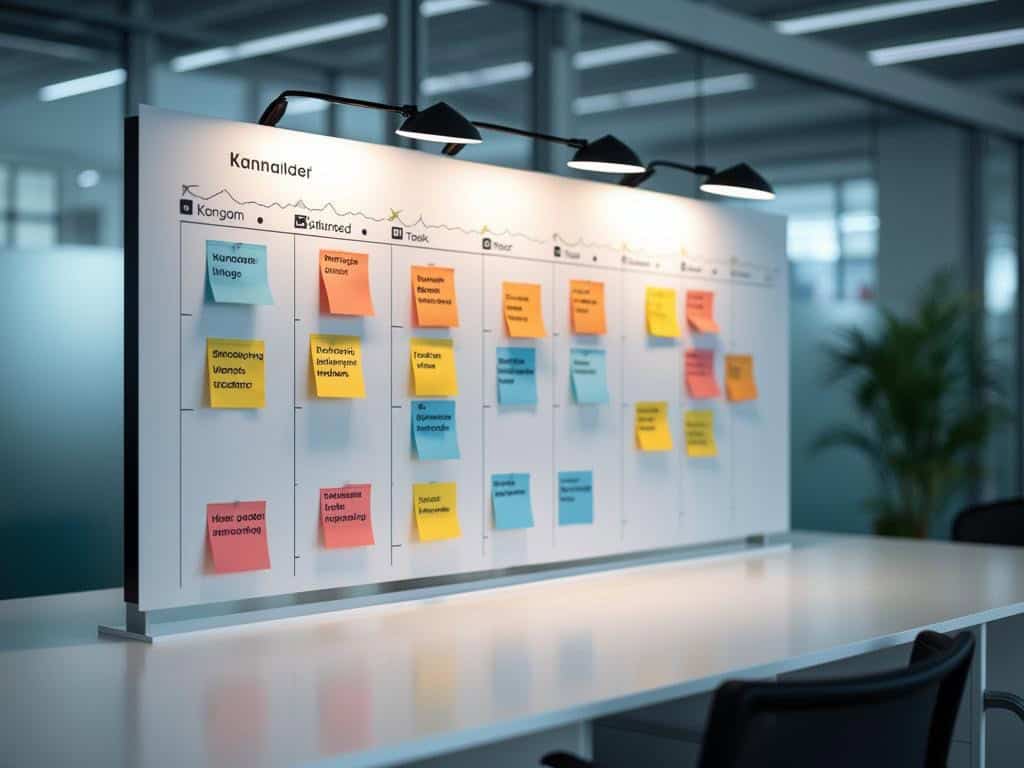
Managing Projects with Kanban
Managing projects with Kanban offers a visual and flexible approach to workflow optimization. This system enables teams to boost transparency and fuel continuous improvement. By implementing Kanban methodology basics, your organization can create a more efficient and adaptable project management system that allows for real-time tracking and incremental progress.
Key Takeaways
- Kanban boards provide a clear, visual representation of work stages and task progress
- Work-in-Progress (WIP) limits prevent team overload and improve task focus
- The methodology supports incremental change without requiring radical process transformation
- Metrics like cycle time and throughput enable data-driven productivity improvements
- Kanban enhances team collaboration and accountability through transparent workflow visualization
Kanban transforms how teams track and complete work. The system originated in Toyota’s manufacturing processes but has found successful applications across various industries. Your team can quickly identify bottlenecks and adjust resources accordingly using the visual cues on a Kanban board.
Moving cards across columns provides immediate feedback on progress. This creates a sense of accomplishment and helps maintain momentum throughout projects. Teams often report increased satisfaction and reduced burnout after adopting this approach.
Setting WIP limits forces thoughtful prioritization and prevents the productivity drain of constant task-switching. Focus improves as team members complete current tasks before taking on new ones. This discipline leads to faster delivery times and higher quality outputs.
The flexibility of Kanban makes it compatible with existing workflows. You can implement it gradually without disrupting current operations. This gentle transition makes it an attractive option for organizations hesitant about major process changes.
Data collection happens automatically as cards move across the board. This gives managers valuable metrics to make informed decisions about team capacity and project timelines. Cycle time analysis helps identify where improvements can have the biggest impact on Kanban performance metrics.
Daily stand-up meetings become more productive with a Kanban board as the focal point. Everyone can see exactly what’s happening, who’s working on what, and where help might be needed. This transparency builds trust and accountability throughout the team.
“Embracing Kanban transforms project management into a dynamic visual journey, where transparency fuels collaboration and incremental progress thrives. By optimizing workflows and setting clear WIP limits, teams not only enhance productivity but also cultivate an environment of continuous improvement without the need for radical change.”
Core Components of Kanban Methodology
Kanban offers a visual and flexible approach to managing projects with kanban boards at its center. You’ll find this method particularly valuable for creating transparency and fostering continuous improvement in your workflow. The methodology consists of several key elements that work together to optimize your project management process.
Essential Elements for Managing Projects with Kanban
The Kanban board serves as the visual backbone of this methodology. When managing projects with kanban, you’ll create a board divided into columns representing your workflow stages (typically “To Do,” “In Progress,” and “Done”). This visual representation helps you track work as it moves through different phases of completion. The project communication becomes clearer as everyone can see the status of tasks at a glance.
Kanban cards represent individual tasks that move across your board. Each card contains essential information about the work item, including:
- Task description and requirements
- Assignee responsible for completion
- Due date or time estimates
- Priority level indicators
- Related dependencies or blockers
Work-in-Progress (WIP) limits are crucial when managing projects with kanban effectively. These caps on the number of tasks in each workflow stage prevent overloading your team. By implementing WIP limits, you’ll reduce multitasking and enhance focus on completing existing work before starting new tasks. This approach aligns with continuous improvement principles by identifying bottlenecks in your process.
The core principles of Kanban emphasize respect for existing processes while encouraging evolutionary change. Unlike other methodologies that require radical transformation, Kanban allows you to start with your current workflow and make incremental improvements. This makes it particularly effective for teams resistant to dramatic changes in their work approach.
| Traditional Project Management | Managing Projects with Kanban |
|---|---|
| Fixed scope and schedule | Flexible and adaptive workflow |
| Batch processing of work | Continuous flow of tasks |
| Management-driven priorities | Team collaboration on priorities |
| Periodic reporting cycles | Real-time visibility of progress |
| Comprehensive documentation | Just-enough information on cards |
By implementing these core components, you’ll create a system that naturally enhances workflow visibility while managing projects with kanban. This visual approach makes bottlenecks immediately apparent and helps you avoid common project management mistakes related to poor visibility and communication.
Companies that implement Kanban report up to a 66% improvement in delivery speed and an increase in productivity of 20-50%.
forbes.com
Enhancing Productivity Through Kanban
Kanban transforms your team’s productivity by creating a clear visual system for managing projects. This visualization technique helps you reduce multitasking—one of the biggest productivity killers when managing projects with Kanban. With designated columns showing work status, you’ll instantly spot bottlenecks that might be slowing your project delivery.
Task prioritization becomes straightforward when managing projects with Kanban. The visual board allows you to clearly mark high-priority items and ensure your team focuses on what truly matters. This approach eliminates the common problem of urgent but unimportant tasks consuming valuable time.
When managing projects with Kanban, you’ll benefit from built-in transparency. Everyone can see the status of all work items, fostering greater accountability and team collaboration. This visibility helps improve project collaboration by creating shared understanding across departments.
Metrics-Driven Improvement
Kanban’s real power comes from its metrics that drive continuous improvement when managing projects with Kanban:
- Cycle Time: Measures how long tasks take from start to completion
- Lead Time: Tracks the period between request and delivery
- Throughput: Counts completed tasks per time period
- WIP (Work-in-Progress): Monitors how many tasks are active simultaneously
These metrics provide actionable insights when managing projects with Kanban. By analyzing cycle times, you’ll identify process inefficiencies that need attention. Tracking lead times helps you make reliable delivery commitments to stakeholders, which is crucial for stakeholder satisfaction.
The feedback loops built into Kanban methodology encourage ongoing refinement. Regular review meetings (often called “Kanban cadences”) create opportunities to discuss performance metrics and implement improvements. This data-driven approach ensures your productivity enhancements are based on facts rather than assumptions when managing projects with Kanban.
| Productivity Challenge | Kanban Solution |
|---|---|
| Task overload | WIP limits prevent taking on too much work |
| Priority confusion | Visual signals clearly mark important items |
| Process bottlenecks | Workflow visualization exposes problems |
| Unpredictable delivery | Metrics provide reliable forecasting ability |
By implementing these productivity techniques while managing projects with Kanban, you’ll create more predictable workflows and deliver better results with less stress. The system’s emphasis on incremental improvement aligns perfectly with modern project delivery frameworks that value adaptability.

Managing Multiple Projects with Kanban
Kanban’s visual approach provides powerful solutions for managing projects with efficiency and clarity. You can handle multiple projects simultaneously through a structured yet flexible system that improves resource allocation and workflow transparency.
When managing projects with Kanban, you’ll discover how easily the system scales across different project types. Whether you’re overseeing software development, marketing campaigns, or construction initiatives, Kanban adapts to each scenario while maintaining consistent visual tracking. The beauty of managing projects with Kanban lies in its ability to give you a comprehensive view of all ongoing work.
Effective strategies for managing projects with Kanban include:
- Color-coding cards by project to create instant visual identification
- Creating dedicated swimlanes for each project or department
- Implementing project-specific WIP limits to prevent resource overload
- Using tags or labels to mark priority tasks across multiple projects
- Setting up consistent review cycles to evaluate progress on all initiatives
Digital Tools for Multi-Project Management
When managing projects with Kanban at scale, digital tools become essential. These platforms enhance your ability to organize, track, and optimize multiple workflows simultaneously. The following table highlights popular Kanban software options for multi-project management:
| Tool | Best For | Key Features for Multi-Project Management |
|---|---|---|
| Jira | Software teams | Custom workflows, advanced reporting, integration ecosystem |
| Trello | Small-medium teams | Intuitive interface, card labels, board collections |
| Monday.com | Cross-functional teams | Customizable views, automation, high-level dashboards |
| Asana | Marketing projects | Timeline views, workload management, custom fields |
For successful implementation across multiple initiatives, you’ll need to foster effective project collaboration among team members. Kanban’s visual nature helps teams quickly identify bottlenecks and address project roadblocks before they escalate.
When managing projects with Kanban, you can track project dependencies more efficiently by visualizing how tasks connect across different initiatives. This approach helps you identify where resources may need reallocation to maintain progress on critical path activities.
The power of managing projects with Kanban comes from balancing flexibility with structure. You can adapt to changing priorities while maintaining visibility across your entire portfolio of work. This creates an environment where teams can self-organize while staying aligned with organizational goals and maintaining clear project communication channels.
Companies using Kanban report 21% more efficiency in managing multiple projects simultaneously.
forbes.com
Implementation and Organizational Benefits
Implementing Kanban creates a smooth transition for your teams while delivering substantial benefits. Unlike other methodologies that demand complete process overhauls, Kanban respects your existing workflows and encourages incremental improvements. This approach to managing projects with Kanban significantly reduces resistance to change.
Key Organizational Advantages
When managing projects with Kanban, you’ll notice immediate benefits throughout your organization. The visual nature of Kanban boards empowers leadership at all levels, creating transparency that drives accountability. Team members can easily spot bottlenecks and take initiative without waiting for managerial directives.
Here are the primary benefits you’ll experience when managing projects with Kanban:
- Reduced resistance to change through evolutionary improvements
- Enhanced decision-making through real-time workflow visibility
- Improved team autonomy and ownership of processes
- Decreased time-to-delivery for key deliverables
- Better resource allocation across multiple projects
The flexibility of Kanban allows for adaptive project management that evolves with your organizational needs. You won’t need to force-fit your operations into rigid frameworks.
Cost and time efficiencies emerge naturally when managing projects with Kanban. By identifying and eliminating workflow bottlenecks, your teams accomplish more with fewer resources. A study by LeanKit found organizations implementing Kanban reported a 37% increase in delivery speed while maintaining quality standards.
The visual management approach helps prevent project roadblocks before they escalate into larger issues. When everyone can see the status of work items, problems become visible earlier, allowing for faster resolution.
Managing projects with Kanban also promotes organizational agility through:
- Quick adaptation to changing priorities
- Balanced workloads preventing burnout
- Clear visual indicators of progress
- Continuous improvement culture
- Streamlined handoffs between team members
Organizations often find that Kanban implementation leads to improved stakeholder engagement as progress becomes visible and predictable. This transparency builds trust with clients and executives who can see actual progress rather than relying solely on status reports.
Implementing Kanban can lead to a 37% increase in delivery speed while maintaining quality standards.
leankit.com
Practical Next Steps for Kanban Adoption
You’ll find that implementing Kanban doesn’t need to be complicated. The beauty of this methodology lies in its simplicity when managing projects with Kanban. Start with an honest assessment of your current workflow before making any changes. This initial analysis helps identify bottlenecks and inefficiencies that Kanban can address.
When adopting Kanban, a gradual approach works best. Rather than overhauling everything at once, introduce elements sequentially:
- Start by creating a basic visual board representing your existing workflow
- Add work-in-progress limits after teams understand the basic principles
- Introduce metrics and measurements once the system stabilizes
- Implement feedback loops and regular review meetings to drive improvement
Training is critical for successful implementation. Your team needs to understand not just the mechanics of managing projects with Kanban but the philosophy behind it. Consider these training approaches for better adoption:
- Hold interactive workshops where teams build their first Kanban boards
- Provide access to online courses or bring in experienced Kanban coaches
- Develop internal champions who can help peers navigate the transition
- Create simple reference materials that reinforce key concepts
Measuring Kanban Effectiveness
You can’t improve what you don’t measure. When managing projects with Kanban, track these key metrics to gauge effectiveness:
- Lead time: total time from request to delivery
- Cycle time: time spent actively working on an item
- Throughput: number of items completed per time period
- Flow efficiency: percentage of time items are actively worked on
A post-implementation review helps evaluate how well Kanban is working. Compare these metrics before and after implementation to demonstrate value to stakeholders.
For long-term success, commit to continuous improvement. Schedule regular review sessions where teams can discuss bottlenecks and suggest modifications. This approach ensures your Kanban system evolves with your organization’s changing needs.
Remember that managing projects with Kanban is about more than just moving cards on a board—it’s about changing how your team thinks about work. The best implementations occur when teams focus on improving flow rather than just completing tasks. With proper stakeholder identification and involvement, Kanban can transform how you handle projects, bringing greater transparency, efficiency, and collaboration to your organization.






